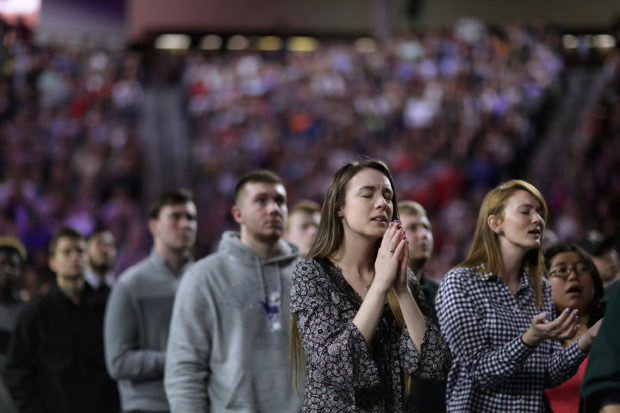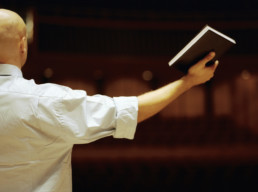The Invitation
The Invitation
Kate Cammell | kac2261@columbia.edu

With her right hand placed over her heart and her left palm opened towards the balcony, Angela Lockett-Colas invited everyone in the church to join in the communion service. The stage lights above her shifted from ice blue to light pink and the eight-member praise band began to play a soft rock melody.
Forefront is an interdenominational church with roots in the Evangelical movement. It’s tucked along a Borem-Hill side street at 509 Atlantic Avenue. During a Sunday morning service, Lockett-Colas, Forefront’s creative director, told the congregation, “Communion is something we do because of the gift we have in Jesus Christ.” As the beat picked up tempo, she reminded the nearly 150 gathered people of the ways that Jesus suffered. “You might feel [persecuted] like that too but you’re loved. You’re loved,” she said.
As Lockett-Colas ushered congregants into the ritual, there was a fullness to her tone that felt assuring, like a mother comforting her children. She beamed as she summoned “anyone” to receive God’s love and to affirm their commitment to Him.
People stood below her on either side of the stage with wooden bowls of bread and large mason jars of red wine, symbolizing the body and blood of Christ. In the Protestant expression of Christianity, communion is a ritual where believers dip bread in wine, and as they eat the mixture they’re asked to reflect on Jesus’ sacrifice.
After Lockett-Cola spoke, members were initially slow to take communion. It was early, so people puttered, like the city buses that had ushered some there that morning. In the last row of the chapel, Georgina Orin followed her friend Grace Dowd into the aisle. Orin’s polka dotted dress sashayed on the wooden floor as she moved in time to the music. Orin, a Californian who once lived in New York, attends Forefront whenever she’s in town.
For Orin, communion is about taking a moment to think about herself in relation to the world around her. Despite the music and the whirl of the lights, there’s a stillness that believers talk about inside themselves. “I think communion is a way to remind you to nourish yourself and that you’re a part of something bigger,” she said.
After reaching the front of the line and dipping the bread in wine, Orin and Dowd made their way back down the aisle. Back at their seats, Orin rested her head on Dowd’s shoulder as they listened to the praise band. People around them raised their hands in the air and bounced on their heels, feeling the music and waiting for everyone to partake in the weekly rite.
Just in case anyone missed Lockett-Colas’s invitation, it was underscored by bold white letters on a large screen at the front of the chapel. “Communion,” the sign announced. Below that it read: “All are welcome at God’s table.” And for Forefront’s members who, like Dowd, identify as queer, seeing “all” written onscreen was key. It’s why many choose to take communion here.
Forefront became an LGBTQ-affirming church in 2014, a controversial move for an Evangelical congregation. The choice was met with loss of both members and funding, but the church stood by its choice. It’s website proudly reads, “We seek community that is inclusive of ALL people.”
Though communion is an individual practice, it’s undertaken—as its name implies—as a community. At Forefront that includes “Conventional Christians and questioning skeptics, Believers and agnostics, Women and men, those of all sexual orientations and gender identities, and Those of all classes and abilities.” It’s a church where juxtapositions are encouraged to rub shoulders.
This is reflected in the communion service as well—old tradition meets new meaning, and, for those who partake of it, a fortification with the warmth of red wine and dance on a chilly February morning in New York City.
Hillsong's Carl Lentz Can't Keep God to Himself
Hillsong's Carl Lentz Can't Keep God to Himself
Madeline Simpson | mms2331@columbia.edu

Carl Lentz enters the stage of Hillsong NYC in the middle of a worship song.
In a light-wash denim button-down and black skin-tight jeans, he worships onstage. He stands behind the worship leaders and raises his hands, his body almost convulsing with the rhythm as he dances and sings. He wears a few silver necklaces (one with a cross dangling from it) and a red bracelet.
When the music fades, he breaks through the line of musicians in front of him and shouts with a slight southern twang.
“Come on! God is good! If you believe that, raise your voices!”
The crowd roars in response. He steps back behind the musicians and the music continues.
Lentz is a celebrity pastor. His Instagram page boasts a blue checkmark, a follower count of 642,000, pictures of his son hanging out with Justin Bieber and basketball games with rapper Drake.
Evangelical churches, especially evangelical megachurches, are often focused around a big personality who leads the church, teaching every Sunday. The sermons are typically based on Bible scripture and taught using engaging stories and analogies from the pastor’s own life.
When the music portion of the service comes to a close, Lentz takes center stage. He is alone, except for a musician who plays keys throughout the sermon (a low-level melodic hum) and two security guards who sit on the far right and far left mini-staircases leading to the stage.
Behind Lentz, a massive screen projects the words, “I Can’t Keep It to Myself” in neon blue cursive.
The pastor opens with a question to the thousands in the crowd: What can you not keep to yourself?
“If you know someone who is in love, if you know someone who is vegan, if you know someone who is a parent... they can’t keep it to themselves.”
Lentz launches into a story about his daughter’s dance recital, about how he could not sit quietly in his chair during the recital. About how he stood up and cheered for his daughter throughout the group performance.
Then, he directs the audience to a bible verse on the screen from the book of Philemon.
As he reads, the crowd responds.
“Come on, pastor.”
“Amen.”
“Really good.”
“That’s good, pastor.”
Some clap in response to Lentz. Some stand on their feet and shout encouragement at him.
When he says something moving and few respond, Lentz calls out the crowd.
“Come on, somebody! You can clap. Twenty other people did!”
The message is a tutorial on how to evangelize. Lentz begins by comparing a life with sharing the story of Christ (“impact on others” leading to “deeper revelation”) to a life without (“minimal impact” leading to “hollow religious patterns”). He talks about how his parents were part of the “Jesus People” movement of the 1970s, about how their goal was to simply share the Good News about the Lord whenever they could.
The sermon is the third that Lentz preached that day—the church holds two-morning services (9:00 a.m. and 12:30 p.m.) and one evening service (5:00 p.m.). His voice is scratchy and becomes scratchier throughout the sermon. Every word is an inspirational shout. He moves around the stage as he preaches, waving his microphone-holding hand so much that his voice fades in and out of pick-up range.
The ultimate teaching point comes when Lentz tells the crowd that their own stories are all they need to share the Gospel.
“The part of your story that you think disqualifies you qualifies you more than anything else… You have to find your rhythm. Find the way you’re going to use your platform.”
The service was set to end at 6:30 p.m., but at 6:50 p.m., they’re still in the midst of song. By the time Lentz closes his sermon in prayer, his face glistens with sweat.
Over the music, which again fills the theatre, he asks the crowd to bow their heads and calls out to anyone who wants to become a Christian—an altar call.
“Raise your hand if you want to know the Lord tonight. That’s right, raise those hands.”
He leads the hand-raisers through the prayer that Christians believe welcomes you into the house of the Lord, thus guaranteeing an eternity in Heaven. A verse from the biblical book of Romans is displayed on the screen: “If you confess with your mouth, ‘Jesus is Lord,’ and believe in your heart that God raised him from the dead, you will be saved.”
The audience breaks into raucous cheers, welcoming their new brothers and sisters into the family of God.
Lentz disappears behind the row of musicians, who close the night.
Hands Stretched in Worship: Hillsong's Rock Concert Church
Hands Stretched in Worship: Hillsong's Rock Concert Church
Madeline Simpson | mms2331@columbia.edu

Arms outstretch, hands rise toward the ceiling of the great theater in upper Manhattan. Some palms open as if to receive a gift. Others face forward, pulsing with the rhythm of the song. No one has a phone out. Voices meld together.
On a massive screen toward the front of the hall, this message flashes:
“I know I don't deserve this kind of love. Somehow this kind of love is who You are.”
The screen flashes again. New words.
“It's a grace I could never add up. To be somebody You still want.”
Welcome to the Sunday praise service at Hillsong NYC, the New York City branch of an international evangelical megachurch. The location in Washington Heights holds three services every Sunday at the Palace, at 175th Street and Broadway.
Worshippers wear skinny jeans and Vans. Joggers and in-style chunky sneakers. At the 12:30 p.m. service, the men and women in the audience are young, but diverse. The main floor fills up five minutes before the service starts and people are directed towards the balcony seats.
On the stage, six singers perform, supported by five other musicians behind them- drums, electric guitar, acoustic guitar, keys, bass.
Some musicians sway back and forth with the music. The voice of a singer with long pink braids rises above the others, eyes closed as she harmonizes and hits impossible notes. A young man on the left of the stage jumps with every note, jubilant.
And then new words flash on the screen, the next lyrics in the worship song.
“But somehow, You love me as You find me.”
The crowd mirrors the musicians on stage. Some stand still. Others sway back and forth. The people filling the space directly in front of the stage jump up and down, moving more than rows further back.
Black mascara tears roll down one woman’s face. Another man sings loudly off key, adding “Yes, Jesus,” “Thank you, Lord” and “Hallelujah” between lyrics.
A young male pastor comes on stage, mirroring the audience in skinny jeans and a black bomber jacket.
“How many of you know that God is calling you to get to a new place of worship?”
The crowd responds, cheering and clapping.
“How many of you know that God wants to know you? He wants to know you!”
The pastor places emphasis on the words “you.” Louder cheering.
“Ask God today to make Himself known to you! Ask God today to enter into a new place of worship with you!”
Each service starts with 20 to 30 minutes of worship. The worship is a communal experience. Each individual in the service sings, raising her voice together with those around her. But she is also instructed by the pastors and worship leaders to take time to reflect. What do the words mean to her? What is God asking her to think about, to sacrifice, to understand, to give up?
Evangelical Christianity emphasizes personal relationship with God, and sets out to create experiences that elevate this relationship. At Hillsong, the music is integral to this. With more than 125 albums from the Hillsong Music label, their music is known around the world, and incorporated into countless worship services every week.
The worship is often interrupted with brief messages by the pastor, pushing the audience to connect deeper, sing louder, raise hands higher.
The music swells and the band continues playing the song.
“I was found, before I was lost. I was Yours, before I was not.”
Near the tenth minute of the song, the worship leader quiets the audience, keeping the music going in the background as he speaks. He invites the audience members to close their eyes and focus on only themselves, honoring God and the privacy of others in the room.
“Listen to what God is telling you right now, and just praise him for it. It doesn’t matter what words you use, or how you sound. Take this moment to raise your voice to the Lord and praise him.”
The crowd erupts, with everyone singing their own lyrics and words. Some bow their heads in prayer, lips moving as they speak with their God. Others shout and jump. Still others continue singing the song that the worship leader is no longer playing.
The music comes back for the final lyric. Voices unite once again, following the lyrics on the screen.
“Grace to spare, for all my mistakes. And that part just wrecks me”



